Abstract
Delayed-type hypersensitivity (DTH) responses to alloantigens were found to correlate with both skin and tumour allograft rejection in 224 reconstituted ATXBM-CBA mice. Furthermore, DTH responses and allograft rejection were observed only in mice that had received Ly-1 cells. Depletion of Thy-1+ or Ly-1+ cells led to indefinite graft survival and the absence of DTH responses, whereas depletion of Ly-2+ cells led to rapid graft rejection and strong DTH responses. The same result was obtained with CBA mice responding to grafts of either C57BL/6 skin, the B16 melanoma, or the EL4 lymphoma; and for (CBA X A)F1 mice responding to H-2K region alloantigens of AQR skin grafts. Thus, DTH and allograft rejection are both mediated by a Ly-1 T cell and it is considered that these are two different manifestations of the same transplantation response.
Full text
PDF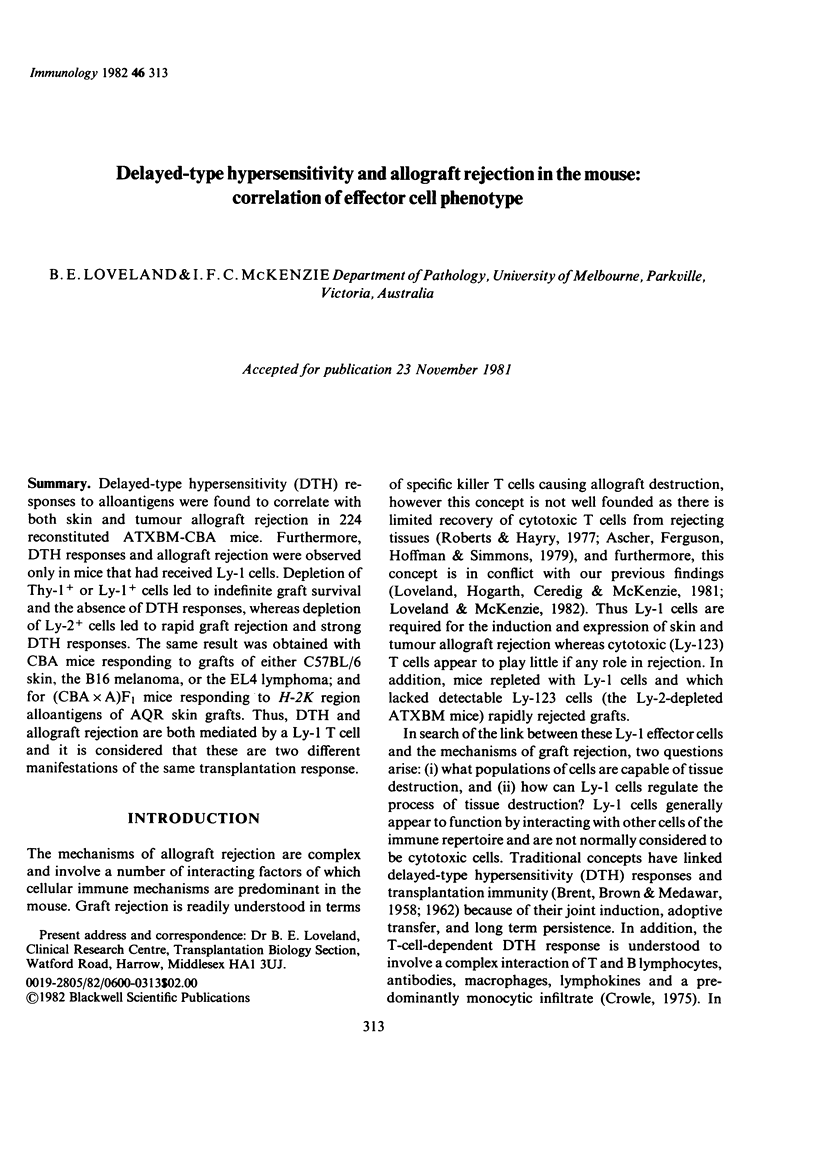
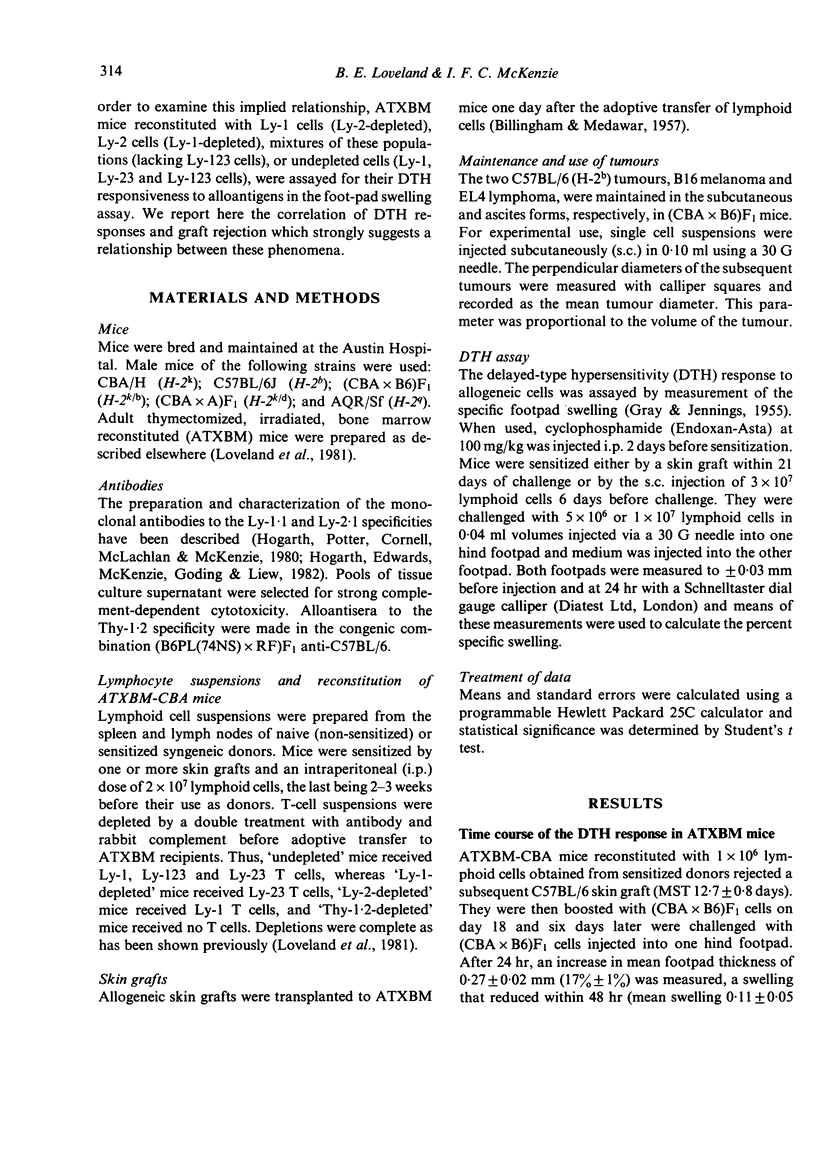
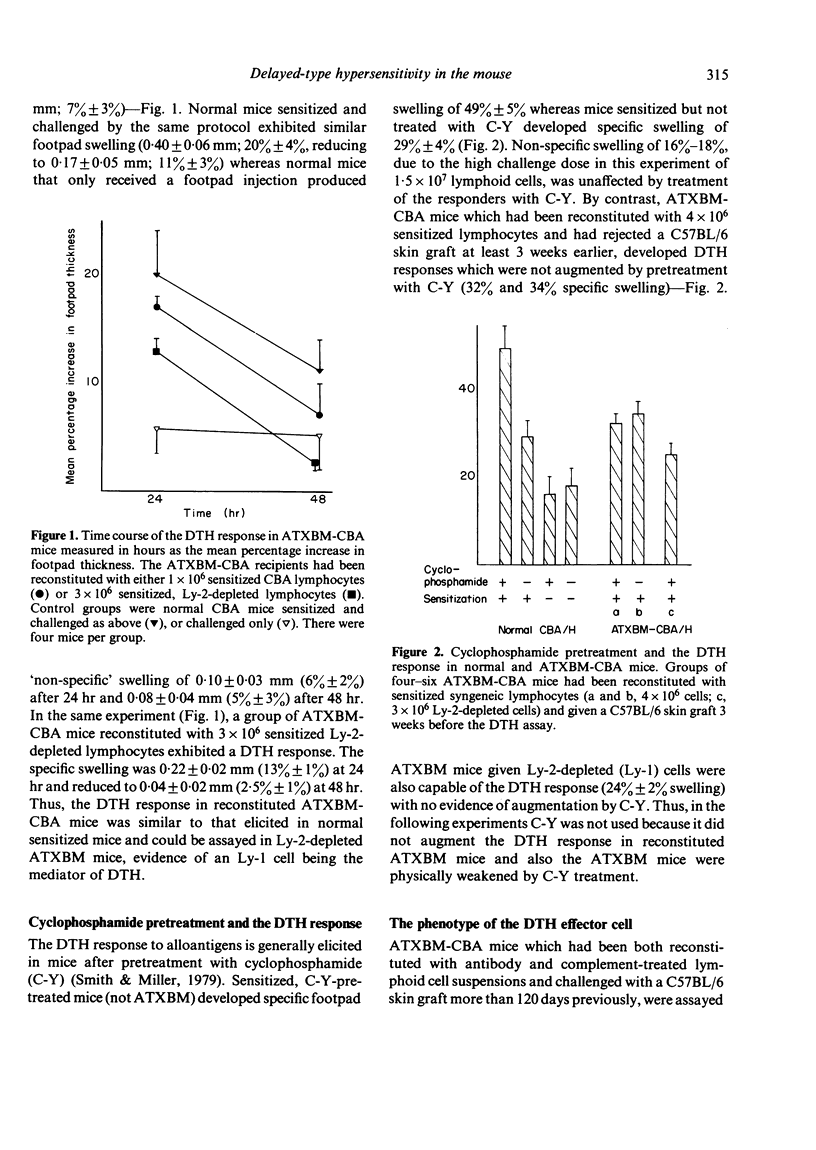
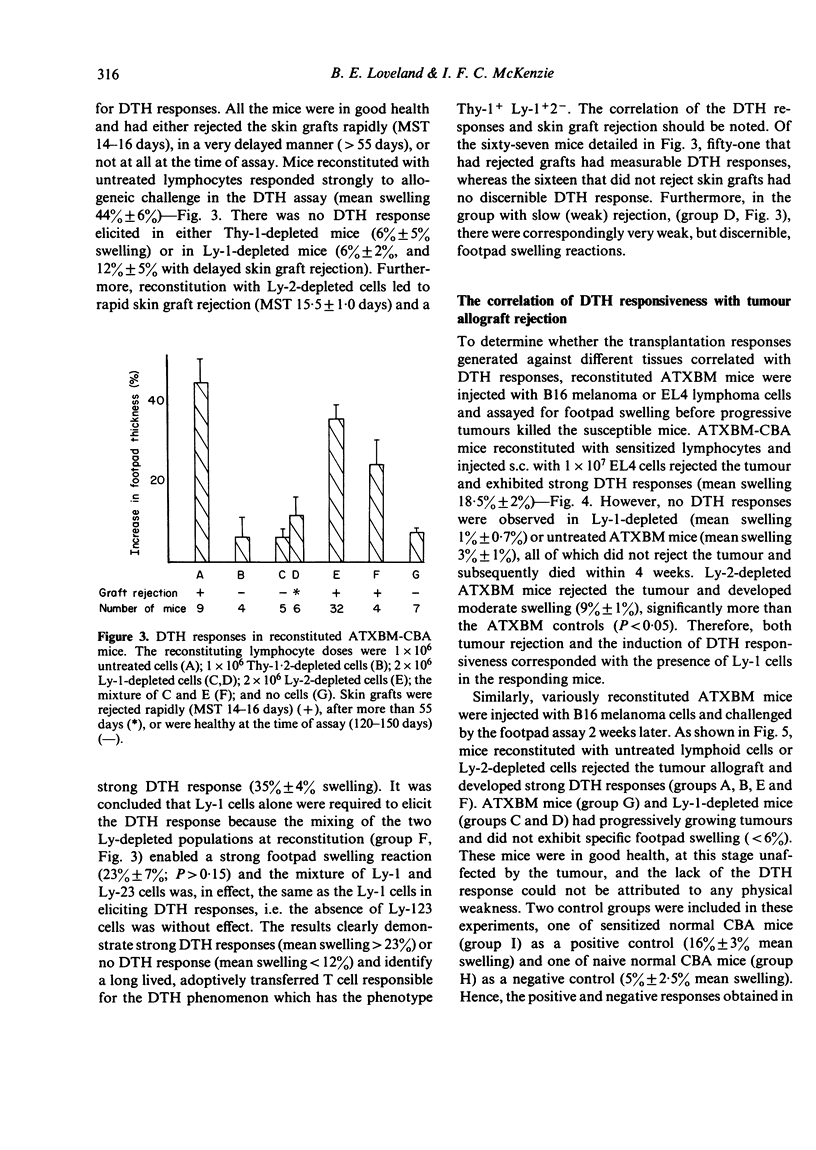


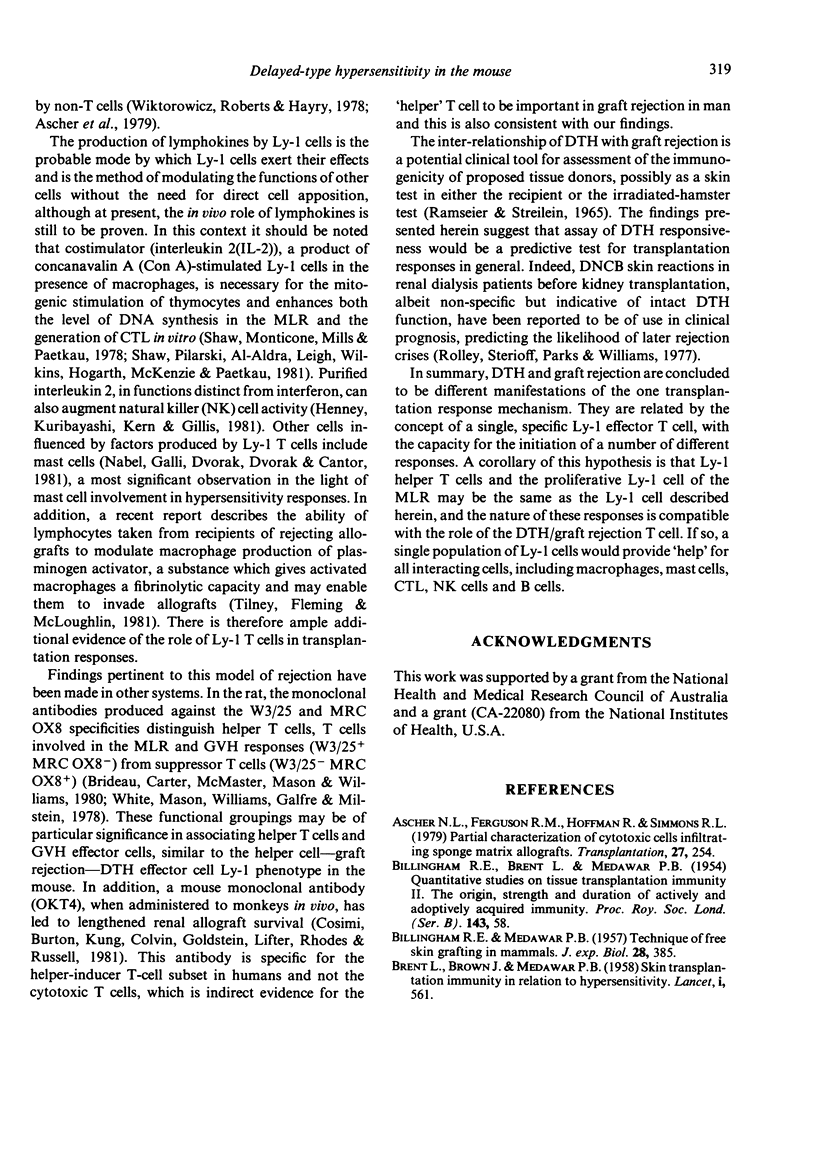
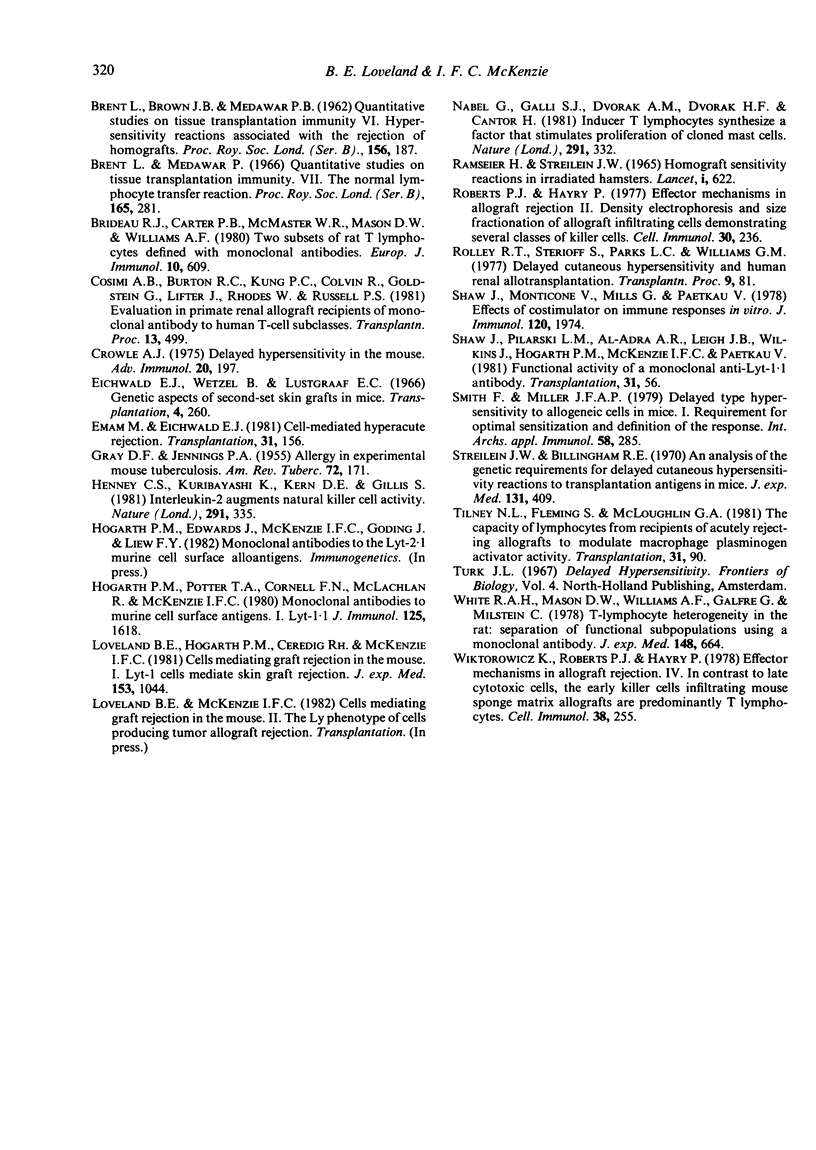
Selected References
These references are in PubMed. This may not be the complete list of references from this article.
- Ascher N. L., Ferguson R. M., Hoffman R., Simmons R. L. Partial characterization of cytotoxic cells infiltrating sponge matrix allografts. Transplantation. 1979 Apr;27(4):254–259. doi: 10.1097/00007890-197904000-00010. [DOI] [PubMed] [Google Scholar]
- BRENT L., BROWN J., MEDAWAR P. B. Skin transplantation immunity in relation to hypersensitivity. Lancet. 1958 Sep 13;2(7046):561–564. doi: 10.1016/s0140-6736(58)90202-2. [DOI] [PubMed] [Google Scholar]
- Brent L., Medawar P. Quantitative studies on tissue transplantation immunity. VII. The normal lymphocyte transfer reaction. Proc R Soc Lond B Biol Sci. 1966 Sep 13;165(1000):281–307. doi: 10.1098/rspb.1966.0069. [DOI] [PubMed] [Google Scholar]
- Brideau R. J., Carter P. B., McMaster W. R., Mason D. W., Williams A. F. Two subsets of rat T lymphocytes defined with monoclonal antibodies. Eur J Immunol. 1980 Aug;10(8):609–615. doi: 10.1002/eji.1830100807. [DOI] [PubMed] [Google Scholar]
- Cosimi A. B., Burton R. C., Kung P. C., Colvin R., Goldstein G., Lifter J., Rhodes W., Russell P. S. Evaluation in primate renal allograft recipients of monoclonal antibody to human T-cell subclasses. Transplant Proc. 1981 Mar;13(1 Pt 1):499–503. [PubMed] [Google Scholar]
- Crowle A. J. Delayed hypersensitivity in the mouse. Adv Immunol. 1975;20:197–264. doi: 10.1016/s0065-2776(08)60209-6. [DOI] [PubMed] [Google Scholar]
- Eichwald E. J., Wetzel B., Lustgraaf E. C. Genetic aspects of second-set skin grafts in mice. Transplantation. 1966 May;4(3):260–273. doi: 10.1097/00007890-196605000-00005. [DOI] [PubMed] [Google Scholar]
- Emam M., Eichwald E. J. Cell-mediated hyperacute rejection. I. Acute, accelerated, and hyperacute reactions. Transplantation. 1981 Mar;31(3):156–159. doi: 10.1097/00007890-198103000-00002. [DOI] [PubMed] [Google Scholar]
- GRAY D. F., JENNINGS P. A. Allergy in experimental mouse tuberculosis. Am Rev Tuberc. 1955 Aug;72(2):171–195. doi: 10.1164/artpd.1955.72.2.171. [DOI] [PubMed] [Google Scholar]
- Henney C. S., Kuribayashi K., Kern D. E., Gillis S. Interleukin-2 augments natural killer cell activity. Nature. 1981 May 28;291(5813):335–338. doi: 10.1038/291335a0. [DOI] [PubMed] [Google Scholar]
- Hogarth P. M., Potter T. A., Cornell F. N., McLachlan R., McKenzie I. F. Monoclonal antibodies to murine cell surface antigens. I. Lyt-1.1. J Immunol. 1980 Oct;125(4):1618–1624. [PubMed] [Google Scholar]
- Loveland B. E., Hogarth P. M., Ceredig R., McKenzie I. F. Cells mediating graft rejection in the mouse. I. Lyt-1 cells mediate skin graft rejection. J Exp Med. 1981 May 1;153(5):1044–1057. doi: 10.1084/jem.153.5.1044. [DOI] [PMC free article] [PubMed] [Google Scholar]
- Nabel G., Galli S. J., Dvorak A. M., Dvorak H. F., Cantor H. Inducer T lymphocytes synthesize a factor that stimulates proliferation of cloned mast cells. Nature. 1981 May 28;291(5813):332–334. doi: 10.1038/291332a0. [DOI] [PubMed] [Google Scholar]
- RAMSEIER H., STREILEIN J. W. HOMOGRAFT SENSITIVITY REACTIONS IN IRRADIATED HAMSTERS. Lancet. 1965 Mar 20;1(7386):622–624. doi: 10.1016/s0140-6736(65)91713-7. [DOI] [PubMed] [Google Scholar]
- Roberts P. J., Häyry P. Effector mechanisms in allograft rejection. II. Density, electrophoresis, and size fractionation of allograft-infiltrating cells demonstrating several classes of killer cells. Cell Immunol. 1977 May;30(2):236–253. doi: 10.1016/0008-8749(77)90068-5. [DOI] [PubMed] [Google Scholar]
- Rolley R. T., Sterioff S., Parks L. C., Williams G. M. Delayed cutaneous hypersensitivity and human renal allotransplantation. Transplant Proc. 1977 Mar;9(1):81–83. [PubMed] [Google Scholar]
- Shaw J., Monticone V., Mills G., Paetkau V. Effects of costimulator on immune responses in vitro. J Immunol. 1978 Jun;120(6):1974–1980. [PubMed] [Google Scholar]
- Smith F., Miller J. F. Delayed type hypersensitivity to allogeneic cells in mice. I. Requirements for optimal sensitization and definition of the response. Int Arch Allergy Appl Immunol. 1979;58(3):285–294. doi: 10.1159/000232204. [DOI] [PubMed] [Google Scholar]
- Streilein J. W., Billingham R. E. An analysis of the genetic requirements for delayed cutaneous hypersensitivity reactions to transplantation antigens in mice. J Exp Med. 1970 Feb;131(2):409–427. doi: 10.1084/jem.131.2.409. [DOI] [PMC free article] [PubMed] [Google Scholar]
- White R. A., Mason D. W., Williams A. F., Galfre G., Milstein C. T-lymphocyte heterogeneity in the rat: separation of functional subpopulations using a monoclonal antibody. J Exp Med. 1978 Sep 1;148(3):664–673. doi: 10.1084/jem.148.3.664. [DOI] [PMC free article] [PubMed] [Google Scholar]
- Wiktorowicz K., Roberts P. J., Häyry P. Effector mechanisms in allograft rejection. IV. In contrast to late cytotoxic cells, and early killer cells infiltrating mouse sponge matrix allografts are predominantly T lymphocytes. Cell Immunol. 1978 Jul;38(2):255–263. doi: 10.1016/0008-8749(78)90056-4. [DOI] [PubMed] [Google Scholar]


